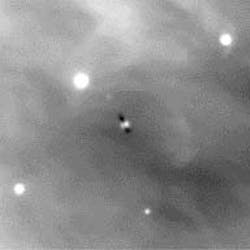
Astronomers at the Very Large Telescope (VLT) in Paranal, Chile have released new color-composite images of the central area of the Orion nebula. The wide-field mosaics probe more deeply into the nebula than any previous images, revealing approximately a thousand very young stars within the so-called Trapezium Cluster. The stars, which have never been imaged before, are estimated to have evolved a million years ago, making them infants in terms of stellar lifetimes.
Mark McCaughrean, with the Astrophysical Institute (Potsdam, Germany), and colleagues used the infrared spectrometer and array camera (ISAAC) on the 8.2-m ANTU telescope to obtain detailed images of the cluster, which is difficult to observe in visible light. In fact, the gas and dust of the nebula normally obscure the dense cluster of stars in the center at visible wavelengths. However, longer wavelengths penetrate the depths of the cloud to reveal the cluster. Excellent conditions at the Paranal site in December 1999 yielded a wealth of striking details in the gas.
The sharp images make it possible to see disks of dust and gas surrounding a few of the young stars, as silhouettes in projection against the bright background of the nebula. Such accretion disks are purported by some researchers to be proto-planetary systems. New details of previously identified Orion silhouette disk 114-426 can be seen edge-on as a dark streak against the background emission of the nebula (see figure).
The resolution of VLT images at infrared wavelengths under best seeing conditions approaches that of the Hubble Space Telescope (HST) in this spectral band. Theoretically, the image sharpness of the 8.2-m VLT is more than three times better than that of the 2.4-m HST. When the high-resolution near-infrared camera and the Nasmyth Adaptive Optics System are installed, the VLT will obtain narrow-field images of even better resolution by compensating for atmospheric turbulence. McCaughrean and his team intend to use the VLT multiobject spectrometers to perform a detailed spectral analysis of the very faintest objects in the cluster.
About the Author
Valerie Coffey-Rosich
Contributing Editor
Valerie Coffey-Rosich is a freelance science and technology writer and editor and a contributing editor for Laser Focus World; she previously served as an Associate Technical Editor (2000-2003) and a Senior Technical Editor (2007-2008) for Laser Focus World.
Valerie holds a BS in physics from the University of Nevada, Reno, and an MA in astronomy from Boston University. She specializes in editing and writing about optics, photonics, astronomy, and physics in academic, reference, and business-to-business publications. In addition to Laser Focus World, her work has appeared online and in print for clients such as the American Institute of Physics, American Heritage Dictionary, BioPhotonics, Encyclopedia Britannica, EuroPhotonics, the Optical Society of America, Photonics Focus, Photonics Spectra, Sky & Telescope, and many others. She is based in Palm Springs, California.
